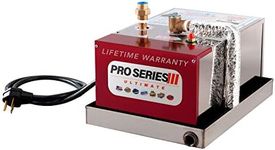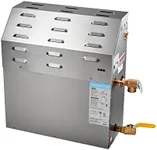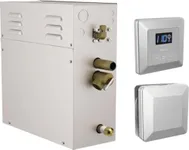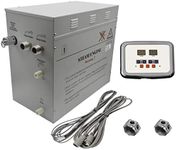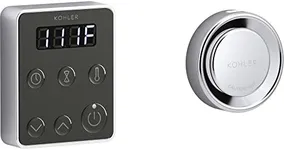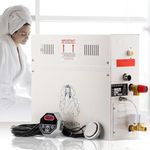Buying Guide for the Best Steam Shower Generator
Choosing a steam shower generator can greatly enhance your shower experience by providing relaxing steam at home. To find the best fit, it's important to understand the main features and specifications that affect performance, installation, and maintenance. By focusing on your bathroom size, usage habits, and installation preferences, you can select a generator that meets your needs and ensures a comfortable, efficient steam shower experience.Power Rating (kW)The power rating, measured in kilowatts (kW), determines how much steam the generator can produce and how quickly it can heat up your shower space. Higher kW ratings mean more steam and faster heating, but also require more electrical capacity. For small shower enclosures, a lower kW (around 6-9 kW) is usually sufficient, while larger or tiled spaces may need 10-15 kW or more. To pick the right power rating, measure your shower's volume (length x width x height) and consider materials like glass or stone, which may require more power to heat. Always match the generator's power to your shower size and insulation for the best experience.
Control SystemThe control system is how you operate the steam generator, including turning it on/off, setting the temperature, and sometimes programming timers or additional features. Basic controls may be simple dials or buttons, while advanced systems offer digital touchscreens, remote controls, or even smartphone connectivity. If you prefer convenience and customization, look for more advanced controls, but if you want simplicity, a basic system may be enough. Think about who will use the shower and how much control you want over the steam settings.
Tank MaterialThe tank material affects the generator's durability and resistance to corrosion. Common materials include stainless steel and aluminum. Stainless steel tanks are more resistant to rust and tend to last longer, making them a good choice for frequent use or hard water areas. Aluminum tanks are lighter and may be less expensive, but might not last as long. If you want a long-lasting, low-maintenance generator, prioritize stainless steel tanks.
Auto Drain FeatureAn auto drain feature automatically empties the water from the generator after use, helping to prevent mineral buildup and extend the life of the unit. Without this feature, you may need to manually drain the tank, which can be inconvenient and lead to maintenance issues if forgotten. If you want a low-maintenance experience and live in an area with hard water, an auto drain is a valuable feature to consider.
Size and Installation RequirementsThe physical size of the generator and its installation requirements determine where you can place it and how easy it will be to set up. Some units are compact and can fit in tight spaces, while others need more room and specific ventilation. Check the manufacturer's guidelines for installation distance from the shower, access for maintenance, and electrical or plumbing needs. Choose a generator that fits your available space and matches your installation capabilities.
Noise LevelNoise level refers to how much sound the generator makes during operation. Some units are designed to be very quiet, while others may produce noticeable humming or clicking sounds. If you value a peaceful, spa-like atmosphere, look for models that emphasize quiet operation. Consider where the generator will be installed—closer to the shower may make noise more noticeable, so quieter models are better for these situations.
Safety FeaturesSafety features can include automatic shut-off, overheat protection, and pressure relief valves. These features help prevent accidents and protect both the user and the equipment. If you have children, elderly users, or want extra peace of mind, prioritize generators with comprehensive safety features.
